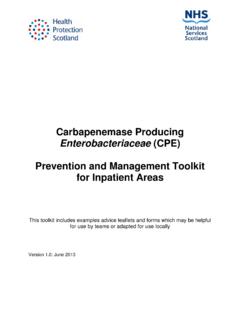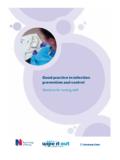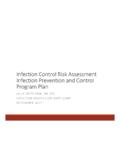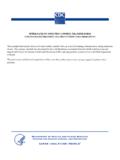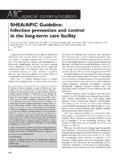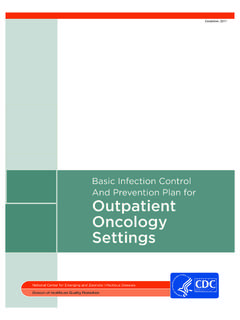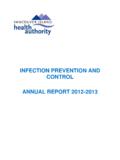Transcription of Infection Prevention and Control in Childcare …
1 Infection Prevention and Controlin Childcare Settings(Day Care and Childminding Settings)Supported byPromoting and Supporting Good PracticeSeptember 2015 Health Protection Scotland. Infection Prevention and Control in Day Childcare Settings. Health Protection Scotland, Glasgow, by Health Protection Scotland, NHS National Services Scotland, Meridian Court, 5 Cadogan Street, Glasgow G2 6QE. Health Protection Scotland is a division of NHS National Services published February 2011 Version 3 published September 2015 First printed July 2011 The Scottish Health Protection Network (SHPN) Guidance Group has supported the development of this document. SHPN is a network of existing professional organisations and networks in the health protection community across Scotland. It aims to promote, sustain, and coordinate good practice. The SHPN supports a systematic approach to development, appraisal and adaptation of guidelines, seeking excellence in health protection practice.
2 Health Protection Scotland 2015 Health Protection Scotland has made every effort to trace those who hold copyright in original material and to get permission to use it in this document and the associated quick reference guide. If we have accidentally used copyrighted material without appropriate permission, we would appreciate if the copyright holders contacted us so that we can acknowledge their copyright as soon as document can be photocopied for the purpose of putting into other requests to reproduce large extracts should be addressed to:Health Protection Scotland NHS National Services ScotlandMeridian Court5 Cadogan SquareCadogan StreetGlasgow G2 : +44 (0) 141 300 1100 Email: and typeset by:Graphics Team, Health Protection ScotlandiInfection Prevention and Control in Childcare Settings: September 2015 Health Protection ScotlandContentsAbbreviations iiiGlossary iv1.
3 About this Document 1 Members of the Guidance Development Group 12. Introduction Risk Assessment Infection Risk Actions to prevent spread of Infection 23. Spread of Infection How germs spread Some basic facts about germs 44. Standard Infection Control Precautions (SICPs) Hand hygiene Respiratory and Cough Hygiene Personal Protective Equipment (PPE) Cleaning of the Environment Equipment cleanliness Dealing with spillages of blood and body fluids Management of waste Linen/Laundry Exposure injuries and bites 85. Food and kitchen hygiene HACCP based Food Safety Management System Training Temperature Control and Food Safety Milk for babies 106. Outbreaks of Infection in Childcare settings Early warning signs and symptoms of Infection 117. The National Care Standards 138. Supporting Bodies Health Protection Teams Environmental Health Services 14 References 15 Appendix 1 Using this guidance as local policy 17 Appendix 2 Farm visits or contact with animals 18 Appendix 3 Exclusion criteria for Childcare and childminding settings 20 Appendix 4 Sample letter to parents when their child joins Childcare setting 23 Appendix 5 Example of a checklist of measures to use during an outbreak of Infection (for example, vomiting or diarrhoea)
4 24 Appendix 6 Health Protection Team contacts in NHS boards 25 Appendix 7 How hands should be washed 26 Appendix 8 Toilet, potty and nappy changing 27 Appendix 9 Example of a cleaning schedule 29 Appendix 10 Keeping toys and equipment clean 30 Appendix 11 Exposure injury or bite 35 Appendix 12 Membership of the Guideline Review Group (2015) 36iiInfection Prevention and Control in Childcare Settings: September 2015 Health Protection ScotlandList of TablesTABLE 1: When should you wash your hands? 5 TABLE 2: When should PPE be worn? 6 TABLE 3: Cleaning of the environment 6iiiInfection Prevention and Control in Childcare Settings: September 2015 Health Protection ScotlandAbbreviationsBS British StandardBSI British Standards Institution CE The initials CE do not stand for any specific words but are a declaration by the manufacturer that this product meets the requirements of the relevant European Control of Substances Hazardous to HealthEHS Environmental Health ServicesHACCP Hazard Analysis Critical Control PointHPS Health Protection ScotlandHPT Health Protection TeamMSDS Material Safety Data SheetsNCS National Care StandardsNHS National Health ServicePHE Public Health EnglandNSS National Services ScotlandPPE Personal Protective EquipmentSCMA Scottish Childminding AssociationSICPs Standard Infection Control PrecautionsivInfection Prevention and Control in Childcare Settings.
5 September 2015 Health Protection ScotlandGlossary Blood and body fluids Blood and body fluids such as urine, faeces (bowel movements), vomit or diarrhoea can all cause Infection . You should only handle them when wearing personal protective equipment (PPE) (for example, disposable gloves).Chain of Infection A series of steps that describes how Infection settings Any setting, except schools, where children are cared for, for example nurseries, day-care centres and children s centres, playgroups, cr ches, childminders, pre-school, after-school care. Children vulnerable Some medical conditions make children more vulnerable to infections that to Infection would not usually be serious in most children. Children vulnerable to Infection include those being treated for leukaemia or other cancers, on high doses of steroids by mouth, and with conditions which seriously reduce their disease A disease that can be spread from one person to Regulations Using chemicals or other hazardous substances at work can put people s health at risk.
6 By law, employers must have controls in place to prevent their staff from becoming exposed to hazardous substances, including infectious agents (for example, germs). See Diarrhoea Three or more loose or liquid bowel movements in 24 hours or more often than is normal for the individual (usually at least three times in a 24-hour period).Disinfectant A chemical that will reduce the numbers of germs to a level at which they are not role The responsibility for using legal powers (including gathering evidence of offences, serving notices, taking samples and, where appropriate, reporting offences to the Procurator Fiscal) to protect the public period The period of time that a person with an infectious disease must be excluded from, for example Childcare settings, to limit the risk of the Infection being passed on to other people. Food business Any business, whether for profit or not and whether public or private, that carries out any of the activities related to any stage of producing, processing and distributing food.
7 Food also includes drinks, chewing gum and any substance, including water, intentionally included in the food when it is made, prepared or handler Someone who directly touches food or surfaces that will come into direct contact with This stands for General Practitioner (your family doctor).HACCP Hazard Analysis and Critical Control Point (HACCP) is a system used to identify and remove risks from food processing to protect those who eat the food. vInfection Prevention and Control in Childcare Settings: September 2015 Health Protection ScotlandHand hygiene The process of cleaning your hands by washing them thoroughly with liquid soap and warm water and then drying them thoroughly or using alcohol based hand-rub solutions. Health Protection Team (HPT) The team of health professionals whose role it is to protect the health of the local population including staff and children in Childcare settings and limit the risk of them becoming exposed to Infection and environmental dangers.
8 Every NHS board has a HPT. Outbreak When there are two or more linked cases of the same illness or when there are more cases than the number expected. Outbreaks can happen anywhere, including in nurseries, in hospitals, on cruise ships and so Protective Equipment Equipment a person wears to protect themselves against one or more risks (PPE) to their health or safety, including exposure to infections . In a nursery setting this would include single-use disposable gloves and disposable aprons. Respiratory droplets Small particles of fluids expelled during coughing, talking, sneezing etc. Germs for example flu, can be transferred from one person to another by droplets travelling small distances and landing on the mouth, nose or eyes of others or in their Infection A set of Control measures which are designed to reduce or remove the spreadControl Precautions (SICPs) of germs to people or within the environment. They include effective hand hygiene, using PPE, how to clean the environment and equipment, how to clean up spills of blood and body fluids and how to deal with waste and linen Prevention and Control in Childcare Settings: September 2015 Health Protection Scotland1.
9 About this DocumentThis document provides guidance on Infection Prevention and Control for staff working within nurseries, day-care centres, playgroups, cr ches, children s centres, childminders, after-school clubs and holiday clubs. This guidance should also be used by these staff involved in all outdoor activities for working with children in Childcare settings have a duty of care to provide a safe environment for children. Social Care and Social Work Improvement Scotland (known as the Care Inspectorate) was set up under the Scottish Public Services Reform (Scotland) Act 2010 ( the Act ) to register and inspect all services regulated under the Act and replaced the Care Commission on 1 April Care Inspectorate must take account of the National Care Standards, Early education and Childcare up to the age of 16 (revised September 2009) when registering and regulating these service types (see section 7).For further information on Care Inspectorate please visit Appendix 1 Using this guidance as local policy for using this document as your local policyMembers of the Guidance Development GroupThis document was developed by a working group led by Scottish Health Protection Network Guidance Group (SHPN-GG) and formed by representatives from Health Protection Scotland (HPS), the health protection community in Scotland, Scottish Childminding Association and Education Scotland, stakeholders and key users, who considered current scientific evidence and expert opinion (see Appendix 12 Membership of the Guideline Review Group (2015)).
10 The HPS Infection Control team retains the evidence notes on which this document is based. The working group also secured public involvement through consultation with parents whose children attend Childcare day settings. The Scottish Health Protection Network Guidance Group (SHPN GG) has facilitated and coordinated the final stages of its development, its adherence to agreed criteria of validation, and its Prevention and Control in Childcare Settings: September 2015 Health Protection Scotland2. Risk AssessmentInfection Prevention and Control in Childcare settings involves carrying out risk assessments and putting measures in place to manage any risks identified these should be reviewed and updated regularly (see Section ). For more information on risk assessments, visit Health & Safety at Work Act 1974 legislates that employers must provide adequate protection against the risks associated with the task undertaken (for example, Personal Protective Equipment (PPE) must be provided for dealing with blood or bodily fluids).
